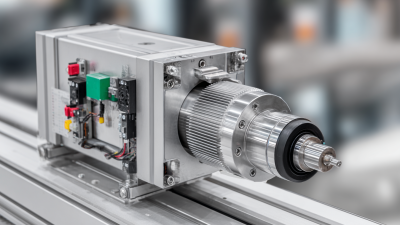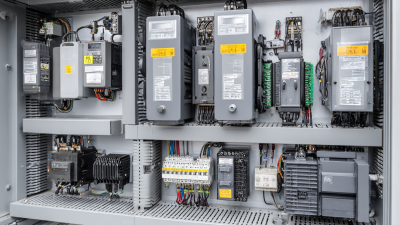The Future of Power Motors Innovations Transforming Transportation and Industry
The evolution of power motors is poised to be a pivotal driver of change in both transportation and industrial applications. As per the latest report from MarketsandMarkets, the global electric motor market is projected to reach $169.9 billion by 2026, growing at a compound annual growth rate (CAGR) of 6.9%. This growth is fueled by the increasing demand for energy-efficient and eco-friendly solutions, alongside advancements in motor technology that enhance performance and reduce operational costs. Power motors are at the forefront of this transformation, enabling innovations such as electric vehicles and automated machinery that not only improve efficiency but also contribute to sustainability goals.

As industries embrace these advancements, the potential to revolutionize energy consumption and operational efficiency becomes apparent, making power motors essential for the future of enhanced transportation and industrial capabilities.
Innovations in Power Motors: Key Trends Shaping Transportation and Industry
Innovations in power motors are playing a critical role in transforming both transportation and industry, shaping the future of how we move and produce goods. One significant trend is the shift towards electrification, as electric motors become the preferred choice for a wide range of applications. This transition not only reduces greenhouse gas emissions but also enhances efficiency, leading to substantial cost savings for both companies and consumers. Manufacturers are increasingly investing in advanced electric motor technologies, such as permanent magnet and synchronous motors, which offer improved performance and responsiveness.
Another key trend is the integration of smart technologies in power motors. The implementation of Internet of Things (IoT) capabilities allows for real-time monitoring and predictive maintenance, which can significantly reduce downtime and improve operational efficiency. In transportation, this innovation enables more sophisticated control systems, paving the way for advancements in autonomous vehicles. In the industrial sector, smart motors can optimize energy consumption and automate processes, driving productivity to new heights. As these trends continue to evolve, the landscape of transportation and industry will be radically transformed, fostering a more sustainable and efficient future.
The Role of Electric Motors in Sustainable Transportation Solutions
As we look towards the future of power motors, electric motors are emerging as a cornerstone in sustainable transportation solutions. According to a report by the International Energy Agency (IEA), electric vehicles (EVs) could account for nearly 30% of global car sales by 2030, signifying a monumental shift in how we approach transportation. The electrification of transport not only reduces greenhouse gas emissions but also enhances energy efficiency, with electric motors being three to four times more efficient than internal combustion engines.
Tips for adopting electric motors include ensuring that proper infrastructure is in place, such as widespread charging stations and smart grid technology. Additionally, industries should consider investing in research and development to optimize electric motor designs, which can lead to significant reductions in costs and performance enhancements. According to a recent McKinsey report, advancements in battery technology could lower EV costs by 50% by 2030, making electric vehicles more accessible to the average consumer.
As companies and municipalities shift their focus toward sustainability, the role of electric motors will only grow. The integration of electric motors in public transportation systems and logistics can lead to a reduction in urban air pollution and overall transportation costs. By harnessing the potential of electric motors, industries can align their operations with future environmental standards, paving the way for a cleaner, more efficient transportation ecosystem.
Advancements in Motor Technology: Enhancing Efficiency and Performance
Recent advancements in motor technology are significantly transforming both transportation and industry, focusing on enhancing efficiency and performance. According to a report by the International Energy Agency, electric motors account for nearly 45% of global electricity consumption in industrial applications. This highlights the critical need for innovation in motor design to improve energy efficiency, reduce carbon footprints, and enhance operational performance across various sectors.
Leading manufacturers are now producing motors that can achieve efficiency ratings of 95% or higher, a marked improvement that can lead to substantial energy savings. For instance, the U.S. Department of Energy estimates that optimized motor systems could save up to $4 billion annually in energy costs, underscoring the economic and environmental benefits of adopting advanced motor technologies. These innovations not only promise to boost productivity but also support industries in meeting increasingly stringent sustainability targets as they shift towards greener practices in response to regulatory pressures and consumer demand.

Integrating Digital Technologies: Smart Motors for a Connected Future
The integration of digital technologies into power motors is revolutionizing transportation and industrial sectors, paving the way for a connected future. According to a report by Allied Market Research, the global smart motor market is projected to reach $12.09 billion by 2026, growing at a compound annual growth rate (CAGR) of 6.5% from 2019. This surge is driven by the increasing demand for energy efficiency and the rise of IoT applications, which enable real-time monitoring and control of motor performance.
Smart motors equipped with advanced sensors and connectivity capabilities not only optimize energy consumption but also enhance predictive maintenance. According to a recent study by MarketsandMarkets, the predictive maintenance market is expected to grow from $3.1 billion in 2020 to $12.3 billion by 2025, emphasizing the importance of data-driven insights in reducing operational downtime. This technological evolution is not just about efficiency; it’s about creating a smarter, more automated ecosystem that empowers industries to achieve higher productivity and sustainability.
Future Challenges: Overcoming Barriers in Power Motor Adoption and Innovation
The rapid evolution of power motors is fundamentally transforming transportation and industrial sectors. However, as we embrace these innovations, it is crucial to recognize and address the challenges that hinder their widespread adoption. The recent international humanoid robotics competition highlighted innovative advancements, yet it also underscored the gaps that still exist in technological integration and practical application.

One significant barrier to the adoption of power motors is the insufficient infrastructure to support new technologies. As industries transition to more sophisticated power systems, ensuring the availability of compatible facilities and resources is critical. To overcome these challenges, collaborations between manufacturers, governments, and research institutions can facilitate smoother transitions and more efficient implementation of innovations.
Tips: Investing in education and training programs can enhance workforce adaptability, ensuring that personnel are well-equipped to work with emerging technologies. Additionally, leveraging public-private partnerships can accelerate the development and deployment of infrastructure necessary for power motor systems. Engaging with end-users early in the innovation process can also help identify practical applications and features that meet real-world needs.
Related Posts
-

5 Best Ways to Optimize Motor Power for Industrial Efficiency
-

7 Reasons Why Your Factory Needs an AC Servo Motor Today
-

Future Innovations in Servo Motor Drivers Shaping Global Industry Trends in 2025
-

Overcoming Common Challenges with Servo Motors: A Deep Dive into Performance and Reliability Issues
-

Advanced Solutions for Enhancing Efficiency with Hollow Shaft Servo Motors
-

Top Strategies for Maximizing Performance with Best AC Servo Drives
